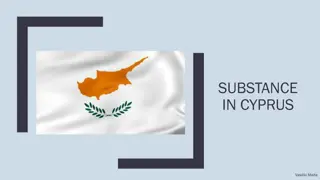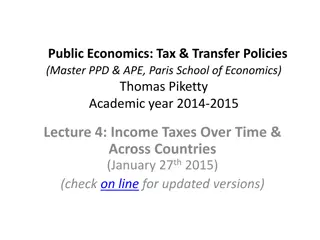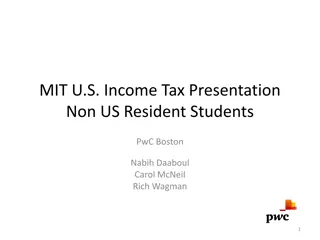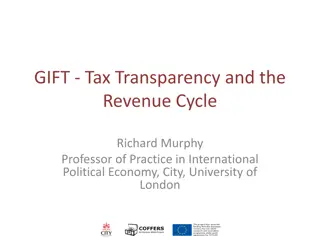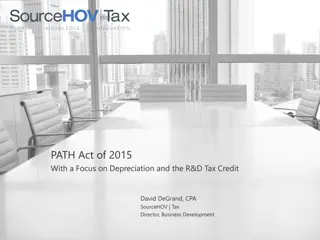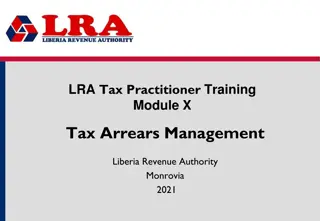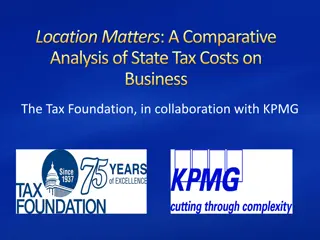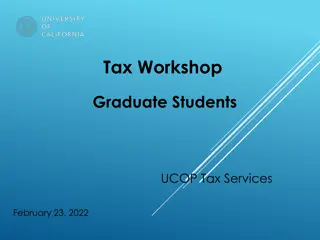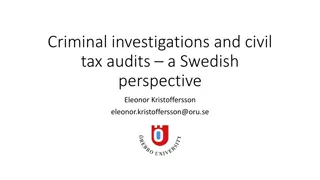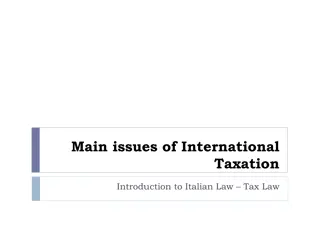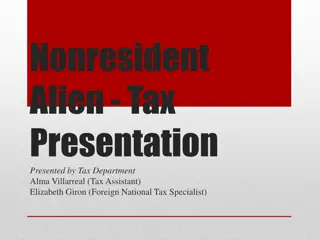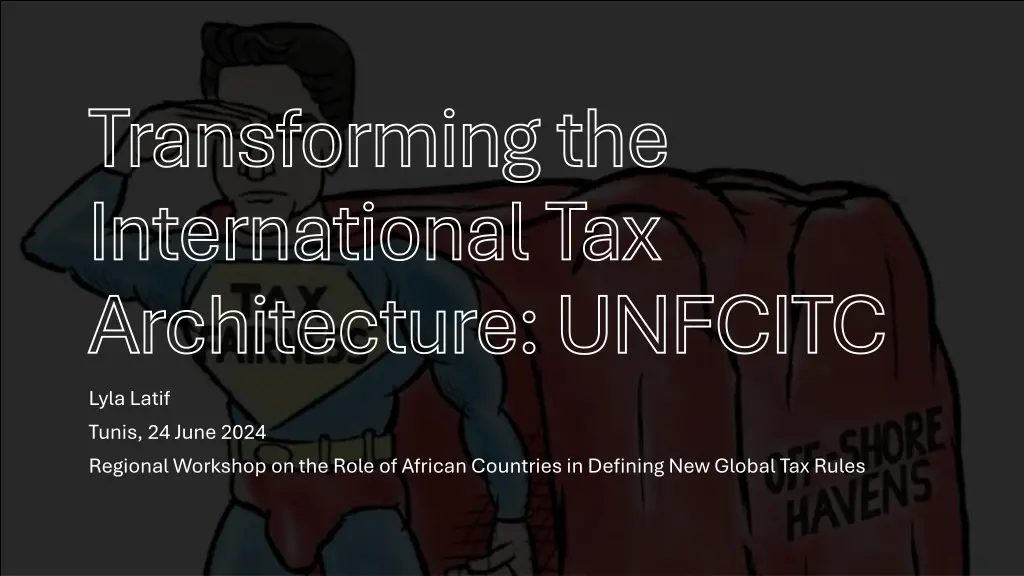
Transforming the International Tax Architecture: Insights from Lyla Latif's Workshop in Tunis
Gain valuable insights into transforming the international tax architecture as discussed by Lyla Latif at a regional workshop in Tunis. Explore key topics such as taxing rights, decision-making processes, international cooperation, STTR, AI, and more. Understand the implications for African countries in defining new global tax rules.
Download Presentation

Please find below an Image/Link to download the presentation.
The content on the website is provided AS IS for your information and personal use only. It may not be sold, licensed, or shared on other websites without obtaining consent from the author. If you encounter any issues during the download, it is possible that the publisher has removed the file from their server.
You are allowed to download the files provided on this website for personal or commercial use, subject to the condition that they are used lawfully. All files are the property of their respective owners.
The content on the website is provided AS IS for your information and personal use only. It may not be sold, licensed, or shared on other websites without obtaining consent from the author.
E N D
Presentation Transcript
Transforming the International Tax Architecture: UNFCITC Lyla Latif Tunis, 24 June 2024 Regional Workshop on the Role of African Countries in Defining New Global Tax Rules
3 Questions WHAT WHY HOW Lyla Latif, Transforming the International Tax Architecture (Tunis, 24 June 2024)
What? 1. Taxing rights Existing asymmetries and correcting them Identification of new sourcing rights and claiming them 2. Decision making rights Rule of majority 3. International cooperation Ending the enabling environment for tax related IFFs, tax base erosion and tax minimisation strategies Addressing the misalignment between legality and ethical responsibility by redefining corporate local responsibility to include fair tax practices Lyla Latif, Transforming the International Tax Architecture (Tunis, 24 June 2024)
Why? Judicial capture Subject to Tax Rule (STTR) AI and Data Lyla Latif, Transforming the International Tax Architecture (Tunis, 24 June 2024)
Judicial capture The OECD deliberately undermining judicial independence by influencing the Court of Justice of the European Union to use terms very similar to those in its use terms very similar to those in its BEPS project when ruling on tax BEPS project when ruling on tax avoidance cases avoidance cases. to This curtails judicial independence, forcing the judiciary to implement OECD's political ideas rather than upholding their duty to deliver impartial justice. Is this not a direct assault on the Is this not a direct assault on the integrity of the judicial process, integrity of the judicial process, compromising the Court's ability to compromising the Court's ability to make independent rulings in make independent rulings in international tax matters. international tax matters. Lyla Latif, Transforming the International Tax Architecture (Tunis, 24 June 2024)
STTR STTR is a Pillar Two global minimum tax package - as a measure to benefit developing countries by allowing them to impose a top-up tax on certain payments made to related entities in other jurisdictions. The commitment by developed countries The commitment by developed countries to include the STTR in treaties is informal to include the STTR in treaties is informal and non and non- -binding. binding. The STTR only applies if specifically only applies if specifically requested requested by a developing country and agreed to by the treaty partner. The STTR can be suspended if a country's can be suspended if a country's economic status changes economic status changes to high-income for five consecutive years. Lyla Latif, Transforming the International Tax Architecture (Tunis, 24 June 2024)
AI AI value chain is incredibly complex and fragmented across multiple jurisdictions. Research might happen in one country, data processing in another, and algorithm deployment in a third. This makes it extremely difficult to determine where value is actually created and how profits should be fairly allocated for tax purposes. Large tech companies, predominantly from the Global North, are extracting valuable data and insights from the Global South. These companies are concentrating immense wealth and intellectual property in low-tax jurisdictions, while the countries providing the raw material - the data - see little benefit. There s a concentration of AI-related intellectual property in the hands of a few powerful actors. This skews the distribution of profits and makes it incredibly difficult for countries in the Global South to capture a fair share of the value created within their borders. Lyla Latif, Transforming the International Tax Architecture (Tunis, 24 June 2024)
Tunisia 9.96 million internet users in Tunisia 7.10 million Tunisians on Facebook Year Year Revenue Revenue ($ bn) ($ bn) 1.97 17.92 85.96 134.9 Profit ($ Profit ($ bn) bn) 0.37 3.66 29.16 39 2010 2015 2020 2023 Lyla Latif, Transforming the International Tax Architecture (Tunis, 24 June 2024)
Practical How? Normative Lyla Latif, Transforming the International Tax Architecture (Tunis, 24 June 2024)
New Rules: Tax adjudication Prohibit the use of language or concepts from any single organisation (like the OECD) as definitive in judicial interpretation Lyla Latif, Transforming the International Tax Architecture (Tunis, 24 June 2024)
New Rules: Taxing Norms 1. Meaningful minimum tax 2. Tiered minimum tax rate that increases with global revenue Progressive Progressive tax tax 15% 20% 25% Threshold Threshold Revenue up to $100mn Revenue up to $500mn Revenue over $1bn Same principle/different threshold for High-Net-Worth Individuals (HNWI) Same principle to apply to tech giants 3. Exit tax a. b. Lyla Latif, Transforming the International Tax Architecture (Tunis, 24 June 2024)
Define exit taxes clearly State that they apply to unrealised gains on assets when a taxpayer changes tax residency. Exit Tax and the UNFCITC Specify that both individuals and corporations can be subject to these taxes, but with appropriate thresholds to avoid undue burden on smaller taxpayers or those making temporary moves. A key principle should be the fair valuation of assets at the time of exit. The convention could provide guidelines for valuation methods, particularly for complex assets like intellectual property or unlisted securities. It should also address timing issues, specifying when the tax liability is triggered and when payment is due.
New Rules: AI AI enabled permanent establishment (PE) Profit attribution based on formula that considers data inputs, user engagement and AI deployment Develop methods to value data and AI contributions to the value chain Extend country by country reporting (CbCR) to include data on AI deployment, data collection and processing activities Consider a global minimum tax specifically for income derived from AI and data driven activities Create mechanisms for countries to tax the extraction and use of data from their citizens Lyla Latif, Transforming the International Tax Architecture (Tunis, 24 June 2024)
Lyla Latif, Transforming the International Tax Architecture (Tunis, 24 June 2024) Links to AI taxation ideas Youtube Link Youtube Link Tax Notes Article Tax Notes Article
Discussion/Questions X: @LylaALatif Email: latif@lai-latif.com Lyla Latif, Transforming the International Tax Architecture (Tunis, 24 June 2024)


![Town of [Town Name] Real Estate Tax Rates and FY 2024 Budget Summary](/thumb/62211/town-of-town-name-real-estate-tax-rates-and-fy-2024-budget-summary.jpg)


